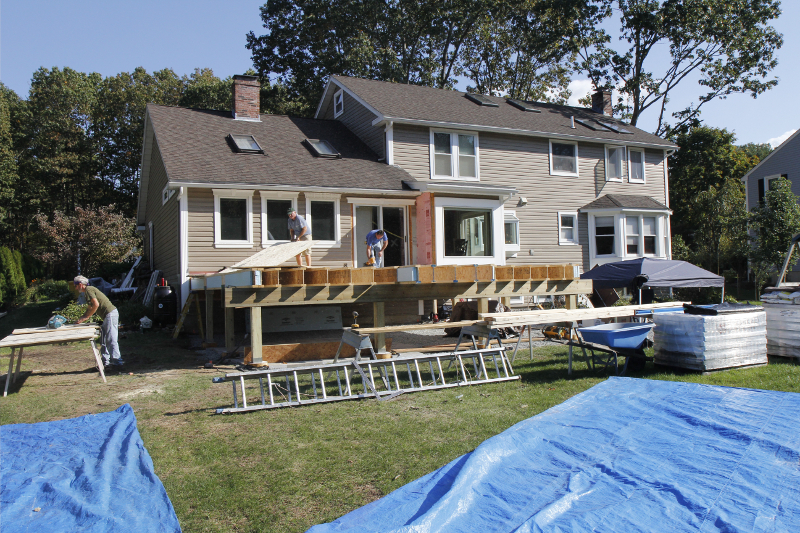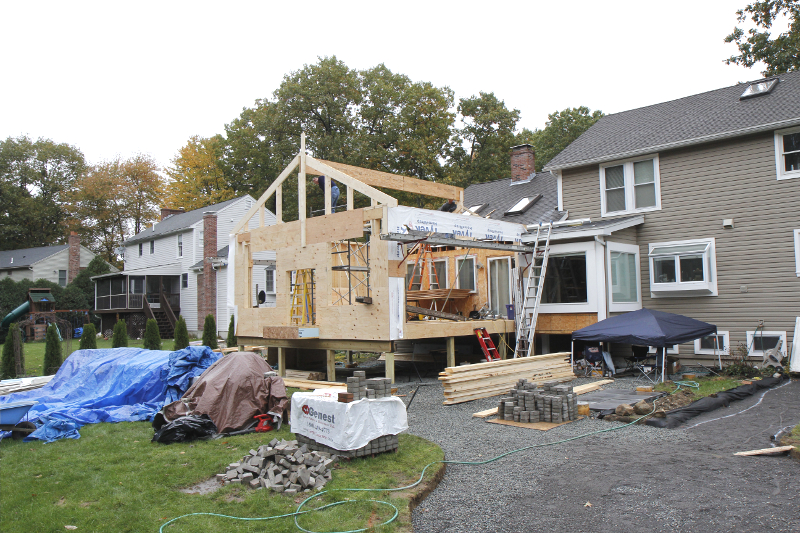A Virtual Visit Strategy
There is nothing like actually visiting a construction site to bring things to life for an Architectural Technology student, but this is not always possible. A memo about mobile video conferencing, an assignment for the course Renovation Techniques (221-540-VA), and a distant site were catalysts for a dynamic strategy for presenting information about residential construction.

The Addition Project at the Start of Construction
A Technological Discovery
My brother had recently put an addition onto his home. He had been very involved with the project, designing, acting as his own general contractor, and taking copious photos of the construction. He was going to allow me to use all of the documentation from the project to teach my course on renovation. I had a great ensemble of information that my students could use, but because the house is situated outside of Boston, there was no possibility of doing a field trip to see the site. When I found out about this video conferencing unit, I thought, “What a fun way to surprise the students with a virtual visit!”
Because it was the first time I was trying something like this, support staff at Vanier College really came to my aid. I met with Nathan Loewen, a teacher at Vanier and Project Director for Virtual Team-Teaching 2012-13 with the Entente Quebec-Canada. We discussed the various options, and he showed me the new MCVU (mobile conferencing video unit), but ironically, with all this technological expertise, Skype ended up being the easiest thing to use.
Working out the arrangements with Jocelyne Trudeau from IT, who was very helpful, we tried various combinations of screens, computers, and rooms, encountering and overcoming difficulties with Skype connections. We settled on using two screens in a viewing room here, and my brother using his desktop computer and laptop. The students would see him on one screen, while he would talk about the construction photos which would appear on the other screen. We both had the construction photos which we numbered. While I was showing the photos here, he was actually going through them on his laptop, so we could synchronize using oral cues.

Framing the House

Closing in the Addition

The Finished Project
A Surprise Visit
On the day of the visit, I introduced the project like any other assignment, giving the students the drawings and documentation, and explaining it in detail.
The assignment was to build upon the existing architectural drawings. The drawings had been prepared using Sketch-up, and, while looking very clean, didn’t give much detail beyond structural information. The students were assigned to draw a section cut in Autocad through the new building, providing complete architectural information as well as the attachment to the existing building.
I finished presenting the assignment, and then said, “Let’s take a fifteen minute break.” I asked them to meet in another classroom. When they walked into the new classroom, there was my brother on the screen, relaxing on the sofa in the new addition, ready to talk to them. It was a complete surprise!

A Perspective from the Project Drawings
While he was going through all his construction photos, I would occasionally stop them and point out where you might notice something on the drawing. They were supposed to be following the construction and also looking at the drawings at the same time. My brother was chatting away, calling himself an educated client. He discussed the whole construction process, why he made certain decisions, what problems he encountered during construction and issues he had with the construction drawings. He provided a lot of useful information, also talking about scheduling and project management, topics that the students were also studying. The students then had a chance to ask questions; Jocelyne had set up the microphone so this was possible.
My students were very happy with the visit. They thought it was really fun, informative, and they loved hearing my brother speak.
After the visit, I provided them with a selection of the construction photos to consult while doing their assignment. They were supposed to take the information from the photo to apply to their architectural detailing, using direct observation.
A Promising Future
I’m not teaching this course right now, but this technology has great educational potential for architectural technology. The visit was very successful, but it would have been even better if he could have walked around while he was talking.
In the future, I can see virtual visits to all sorts of buildings and construction sites. While it is great to see the real thing, a combination of real and virtual tours would allow us to visit more often and to a variety of locations. Some construction sites already have cameras set up for “virtual” supervision of construction. If we could virtually visit their site once a week or once every two weeks, seeing the progression of the construction would be a way of making the theoretical information of our courses transfer into the real world.

